The 5 degrees of link relevance
SEO is easy enough, in theory. The strategies are obvious if you’ve been around the block.
What’s hard about SEO is the actual execution and implementation. The consistency. On a daily basis.
Nowhere is this more obvious than link building.
This article will explain why.
You’ll also learn how to use the “5 degrees of link relevance” framework to craft the best theoretical strategy and the best path to consistently build high-quality, relevant links over the long run.
The 5 degrees of link relevance
Quickly jot down a list of the “best” and “most relevant” links in your space.
Go ahead. I’ll wait.
- What are their characteristics?
- How are they similar?
Here’s the thing most people misunderstand about link building:
You need both quality and quantity to compete in the most lucrative spaces against online behemoths.
Just one or the other isn’t good enough.
And that poses a problem.
Because it forces you to redefine commonly held preconceptions, like “link relevance,” into a more practical definition.
You see, “relevance” isn’t binary. It’s not black and white.
Yes, it can be completely “not relevant.” A link from a Viagra site is definitely not relevant to an insurance broker.
But beyond that, there are often different “degrees” of relevant links. It’s more of a fluid spectrum, where links can be both “highly” or “slightly” relevant.
And when shooting for scale, you need both!
So let’s break this down even further, using my framework, to show you how to prioritize link relevance based on the strategies and tactics that best suit each.
You’ll see that the bulk of link building strategies and tactics you use should fall into the middle zone vs. getting stuck at either extreme end.
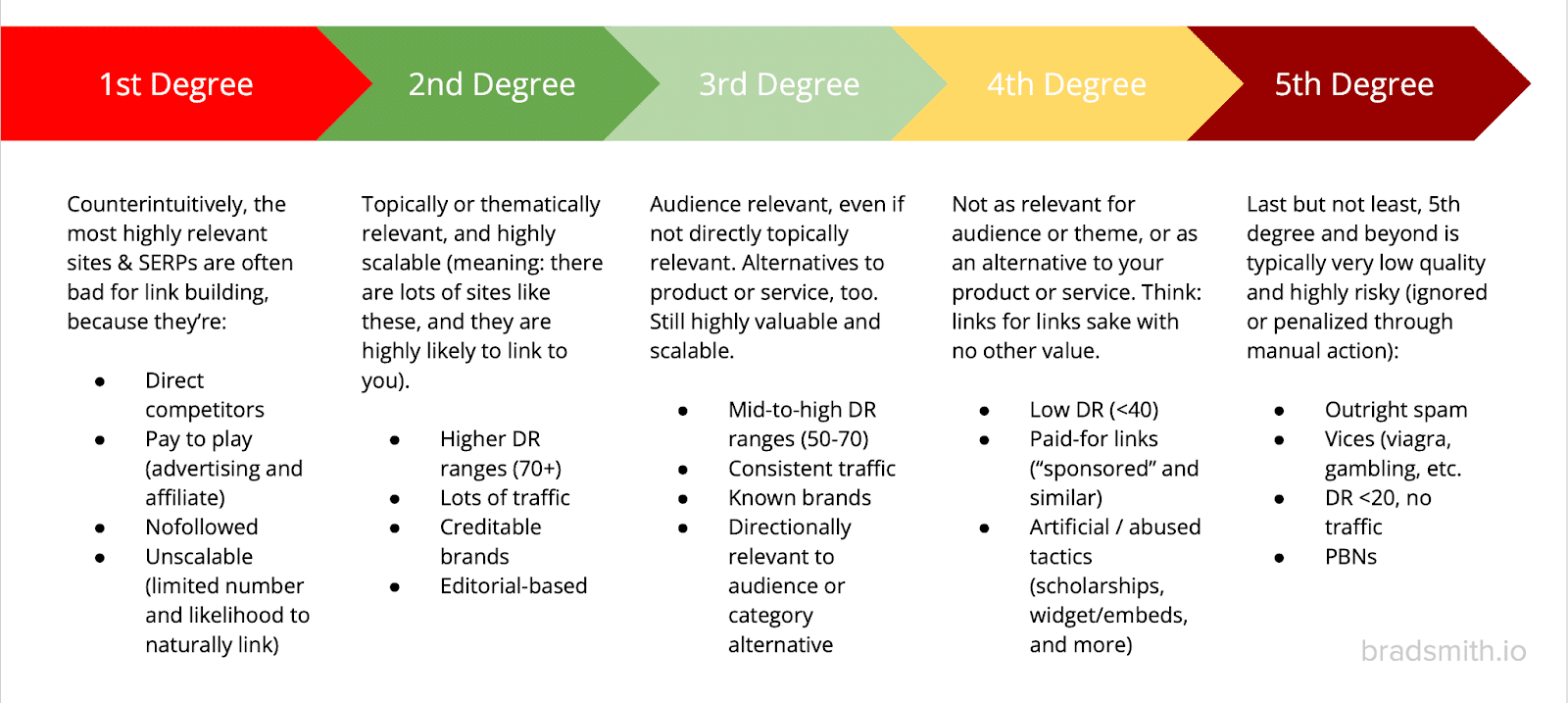
First degree: The ‘most’ relevant, yet often least scalable
When you ask people what the “most relevant” links are in your space, they often give you First Degree answers.
But here’s the problem with those.
Counterintuitively, first-degree links usually aren’t highly scalable.
The most highly relevant sites and SERPs in your space are often bad for link building because they’re:
- Direct or indirect competitors.
- “Pay to play” (advertising and affiliate).
- Nofollowed.
- Unscalable (limited number and likelihood to naturally link).
Another way to think of this problem is through the lens of a simple matrix. Each axis balances “quantity” and “quality.”
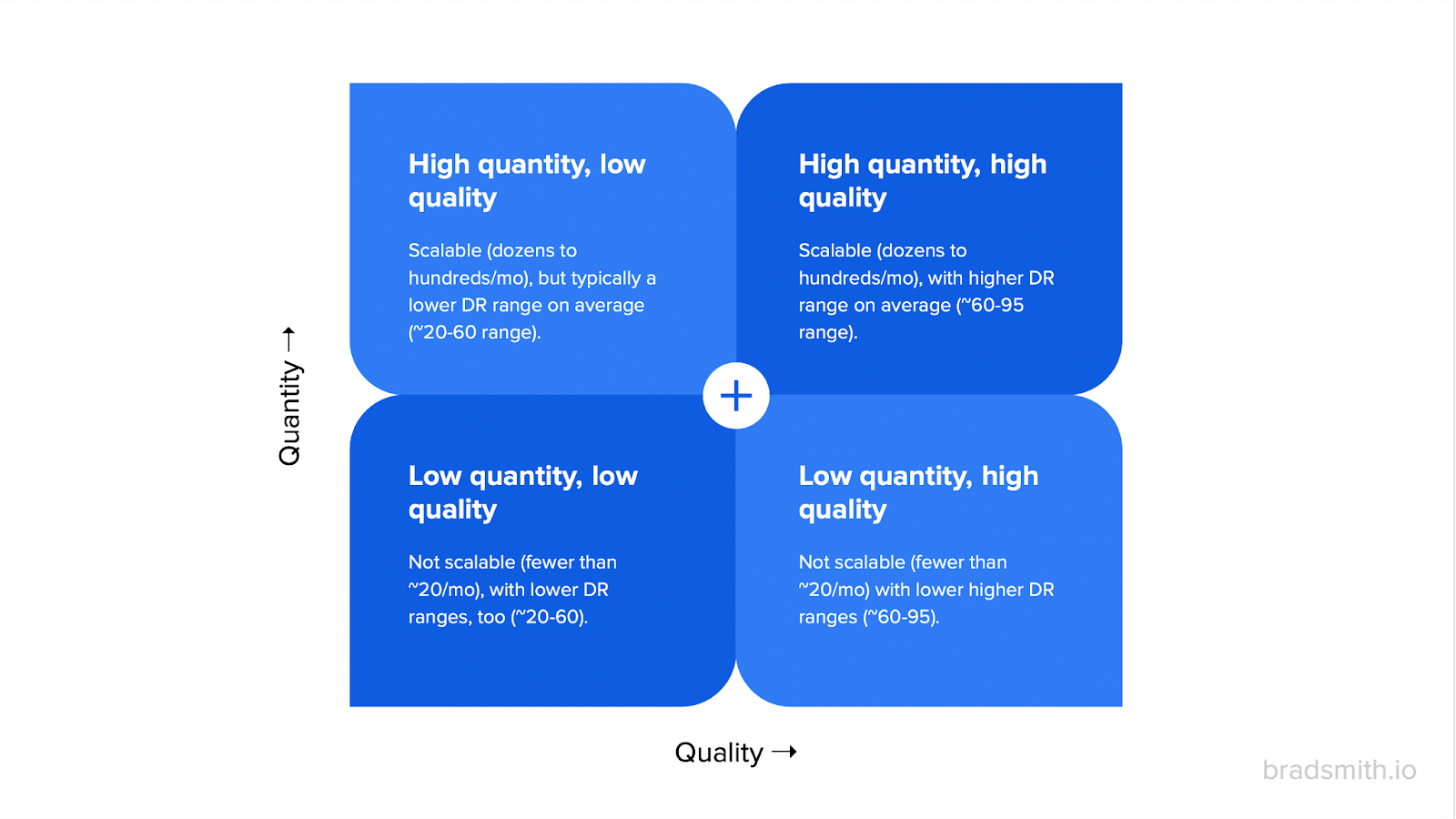
And first-degree links, while certainly high quality, are very low quantity by definition.
That’s because the sites often ranking at the top of the most competitive SERPs in your space already fall into one of the following categories:
- Competitors won’t link to you.
- Pay-to-play sites are expensive to scale.
- Nofollowed sites have some benefit, but not ideal.
- And they’re “unscalable” by definition.
Unpacking this last point, consider a major media brand like The New York Times.
There’s both a tiny finite number of sites like this, and also, the likelihood of them linking to you (without an eight-figure sponsorship deal) is very, very, very, very, very, very, very, very low.
So, yes. You should look for and get as many of these as possible. For instance, sponsoring a nonprofit in your space is an easy win-win.
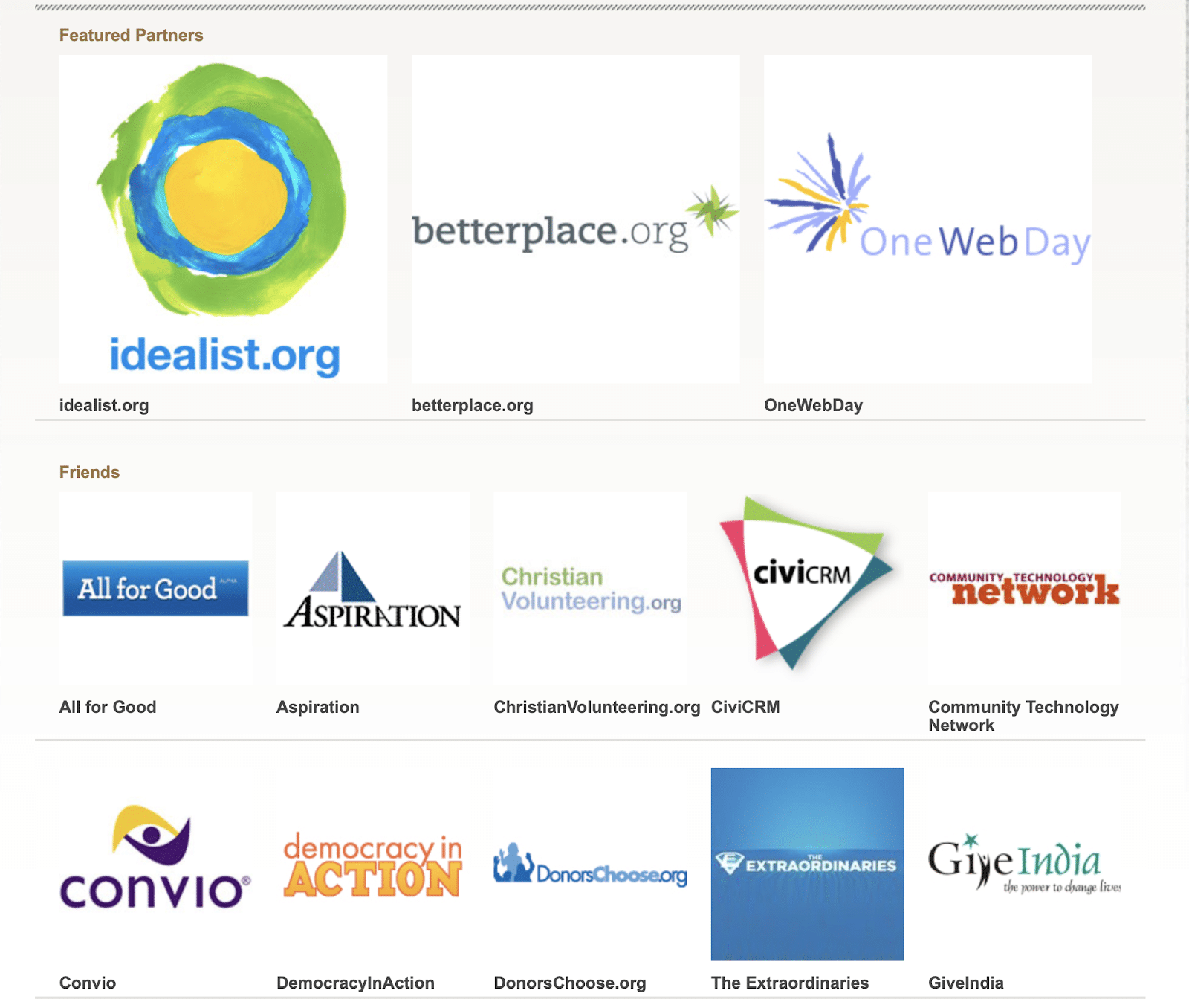
But…
There’s only so many of these to go around!
And on a comparison basis, the effective “cost per link” (even if it’s a traditional or flat-fee sponsorship) becomes prohibitively expensive to scale into the thousands (if not tens of thousands of referring domains) needed to compete in the Major Leagues.
For instance, how much do you think this content syndication costs between NerdWallet + CNBC?
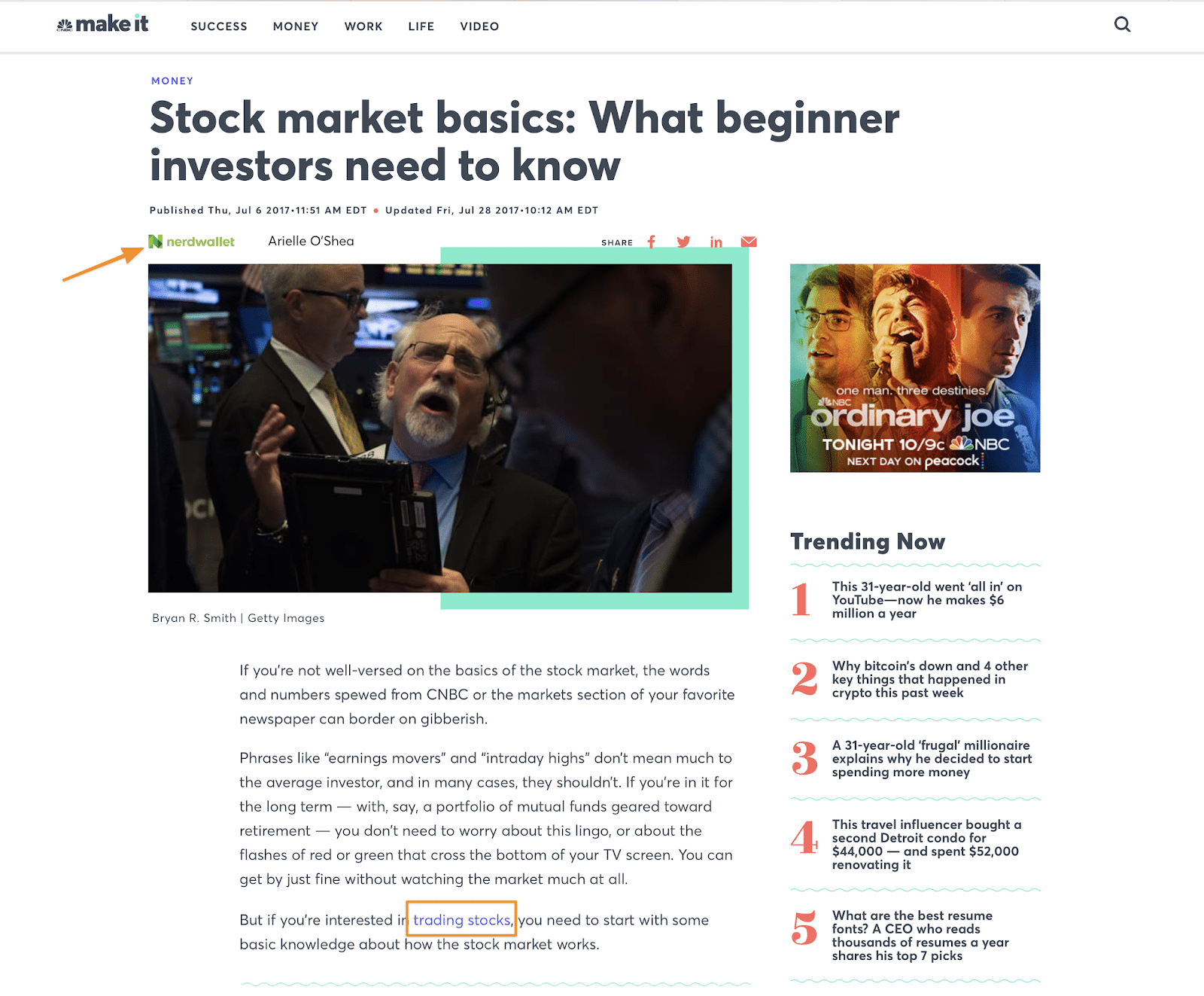
No clue. But I also bet it’s significantly more than your company’s entire marketing budget.
So instead of fruitlessly floundering around with major media sites or direct and indirect competitors already ranking, you need to readjust your definition of relevance to become something more easily attainable.
Second degree: Highly relevant and scalable
Second-degree links are high quality, relevant and scalable.
This is your sweet spot!
Second-degree links are topically or thematically relevant and highly scalable (meaning: many sites like these are highly likely to link to you).
Here are a few of the characteristics you’re often looking for:
- Higher DR ranges (70+)
- Lots of traffic
- Credible brands
- Editorial-based
In other words, this is your high-quality and high-quantity focus!
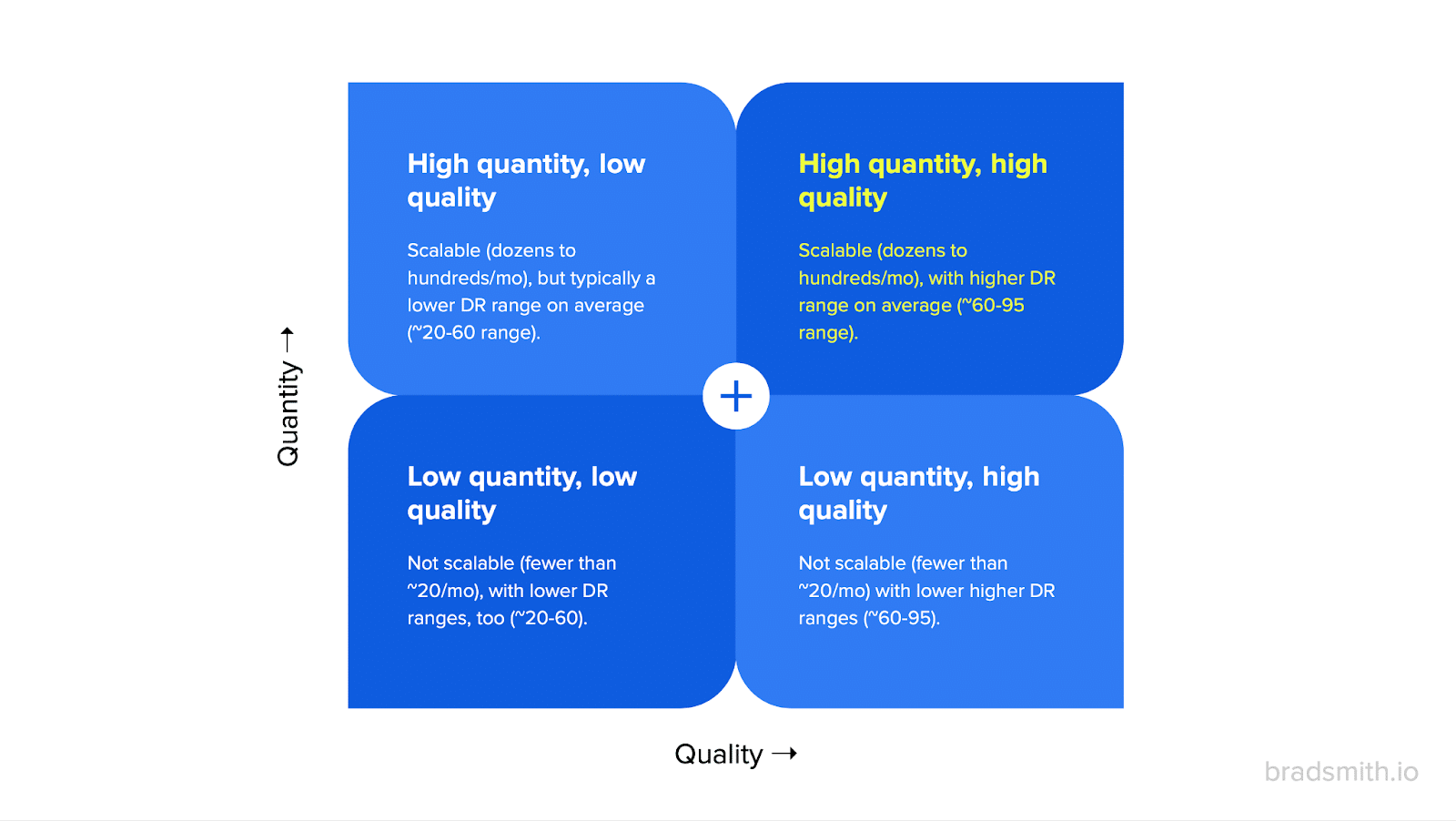
Why is this seemingly semantic difference important?
Because thinking in this fashion helps you uncover the optimal tactics you should be using to get as many of these links as possible!
For instance, generally speaking, certain tactics are better (or worse) to use to reach sites of a certain size (and prestige).
If you broke it down by Domain Rating (DR) or Domain Authority (DA) ranges, it would look something like this:

In other words:
- DR/DA 0-30 sites? Don’t bother actively chasing links.
- DR/DA 30-60: Outreach-based methods tend to scale better in this low-to-medium-tier of sites.
- DR/DA ~60-90: Whereas you’ll often need an editorial-based strategy and partnerships to reach this sweet spot of sites that move the needle.
- DR/DA 90+: And these are your first-degree links above that might be simply unattainable or too expensive (you need good personal relationships or LOTS of $$$).
A perfect example of second-degree link building would be Candor’s “Hiring Freezes” link magnet play at the height of COVID-19.
They created a valuable resource, rounding up real-time employment status during an uncertain time:
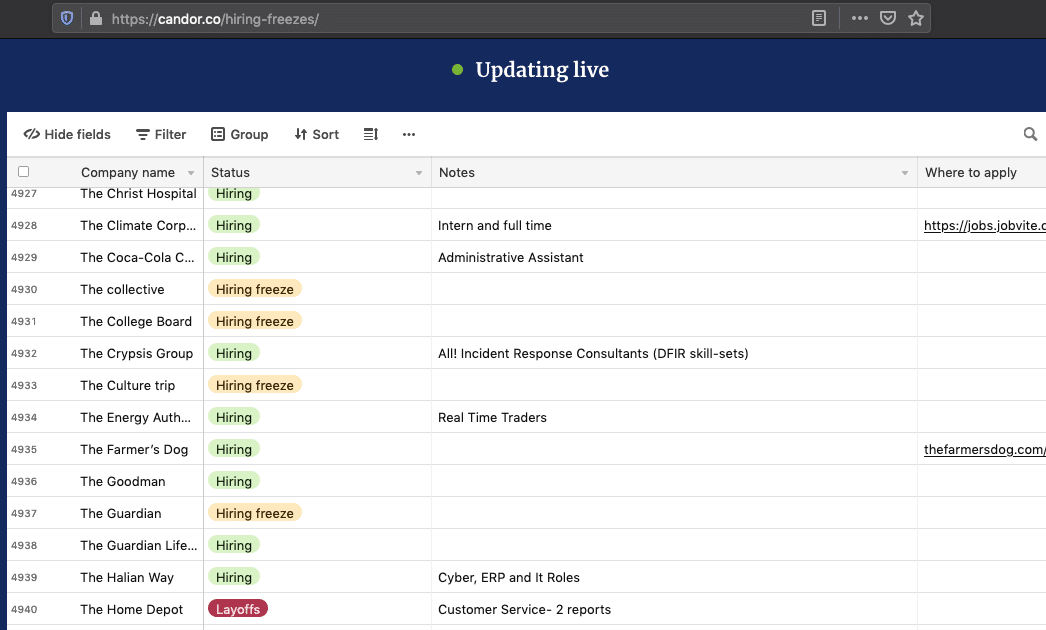
Then, they leveraged that resource to get attention and visibility and some high-quality links from editorial-based sources like VentureBeat (an industry publication vs. mainstream media).
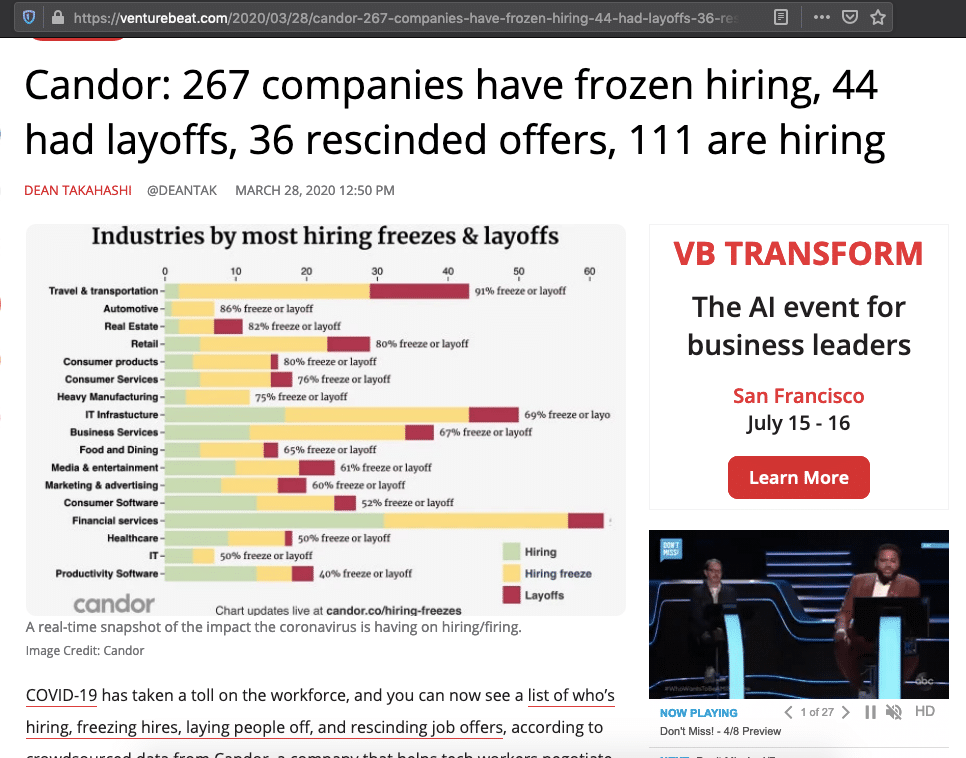
This strategy has the added bonus of leveraging long-term.
Here’s how:
- Instead of spending more on the expense (or distribution, like cost per link building, CPC of an ad or CPL for affiliates, etc.), you
- Spend more on the asset (the content!), bringing down the effective cost per link or click or lead on the expense side of the balance sheet.
This last point is super important. Write it down.
Because the good news is that most of your competitors will ignore and invert it.
You shouldn’t.
Get the daily newsletter search marketers rely on.
See terms.
Third degree: Audience relevant and still highly scalable
OK, now for the fun section.
Third-degree links are critical in driving quantity during a link building campaign.
The trick is to find enough of them that are still relevant, even though they purposely won’t be the “most” relevant (like the first or second degree examples above).
So here’s how you think about these.
Third-degree links are audience-relevant, even if not directly topically relevant. These can be alternatives to a product or service, too (i.e., an alternative solution to your primary product or service). And they’re still highly valuable and scalable!
Examples here include:
- Mid-to-high DR ranges (50-70)
- Sites with consistent traffic
- Known brands in that niche or vertical, despite not mass market appeal
- They’re directionally relevant to audience or category alternative
Let’s take a step back and think of your buyer’s journey for a second.
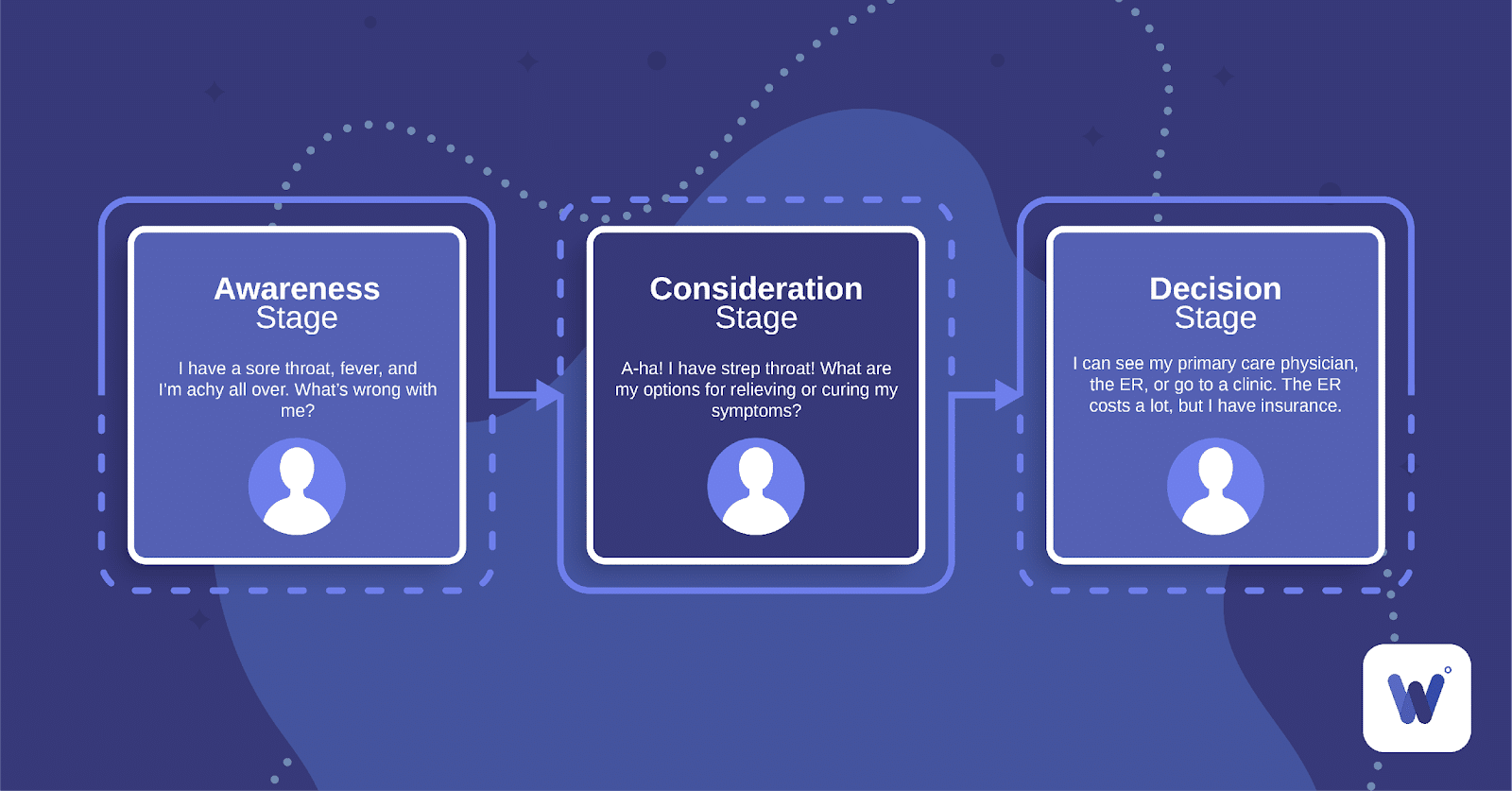
Most first and second-degree links are closer to the bottom of the funnel, focused primarily around who you are or what you do for people (i.e., the product or service you have, the primary audience that needs you right now, etc).
As an example, let’s say you sell Pet Insurance. So most people think “relevant” is something around “insurance” or “people looking for pet insurance.”
Yes. And no.
Again: you have no scale there!
Do you think anyone else talking about “pet insurance” on the internet is likely to link to you? The answer is no, because they’re probably already a direct or indirect competitor.
Plus, it’s super niche.
So instead, you need to move up-funnel.
Ask yourself: What kind of big, active online audiences would buy pet insurance?
Mom blogs!
Are mom blogs “highly relevant” to pet insurance?
- From a classic, old-school, traditional SEO standpoint, maybe not.
- But from a broader marketing and actually revenue-driving position? Yes, of course!
Who do you think spends money on new pets, takes care of existing pets, and spends the bulk of their time taking care of them?
Moms and their kids!
(Stereotypical, I know. But this is still directionally accurate across the world. Moms usually still do most of the hard work with kids and pets.)
So instead of trying to get other insurance companies to review your product – ‘cause, they won’t – you get (or incentivize) mom blogs to talk about your pet insurance.
This gives you a relevant link and can potentially drive more revenue.
The link is audience-relevant, even if it’s not directly relevant to your space or product (insurance).
Most product reviews of all shapes and flavors honestly fall into this category.
An organic skincare brand, then, would target every single “natural,” “sustainable” and “eco-friendly” blog in the world.
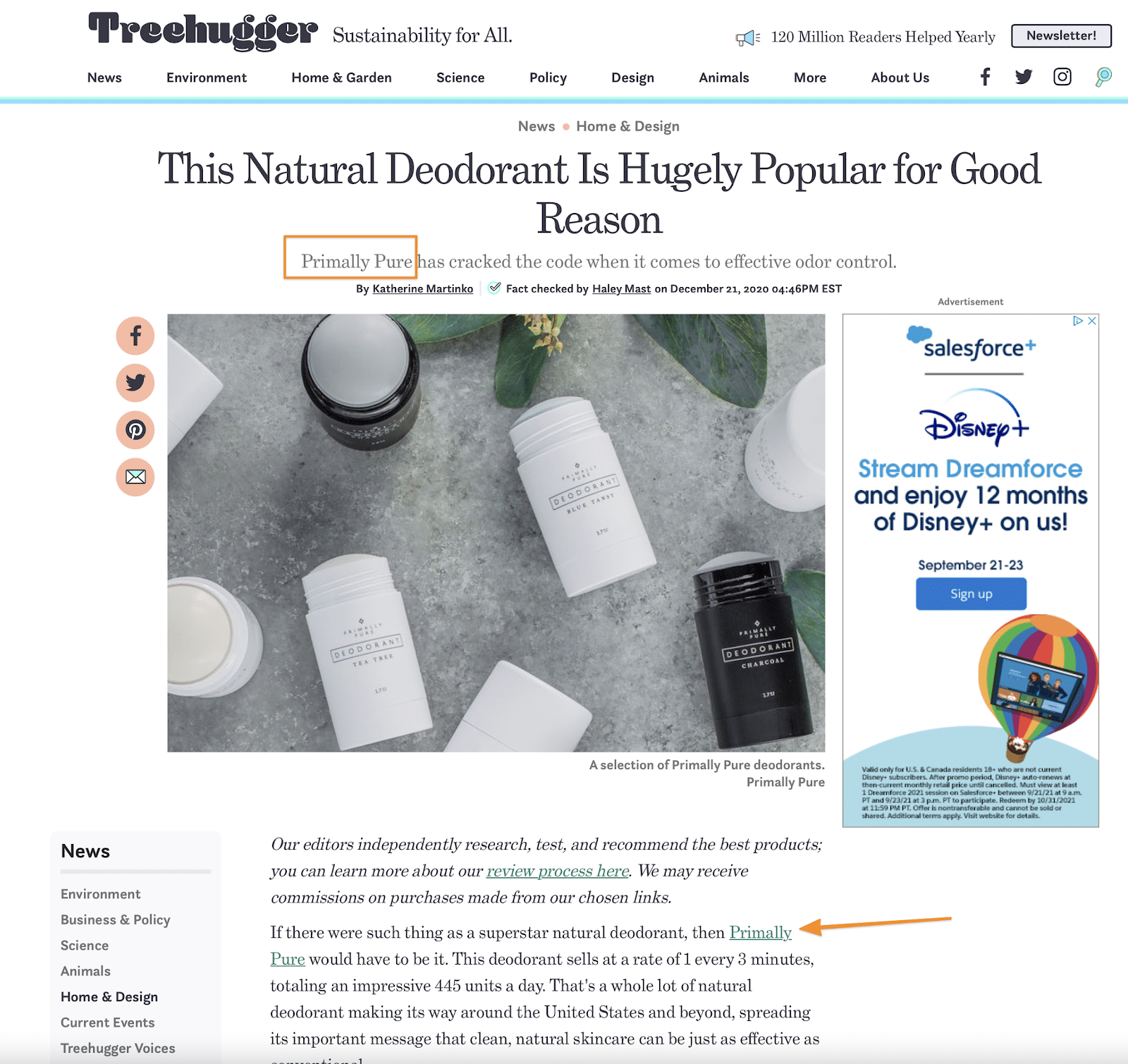
The key with second and third-degree links is to realize:
- These sites don’t need to link to you, so…
- You need to help them first by solving a need they already have.
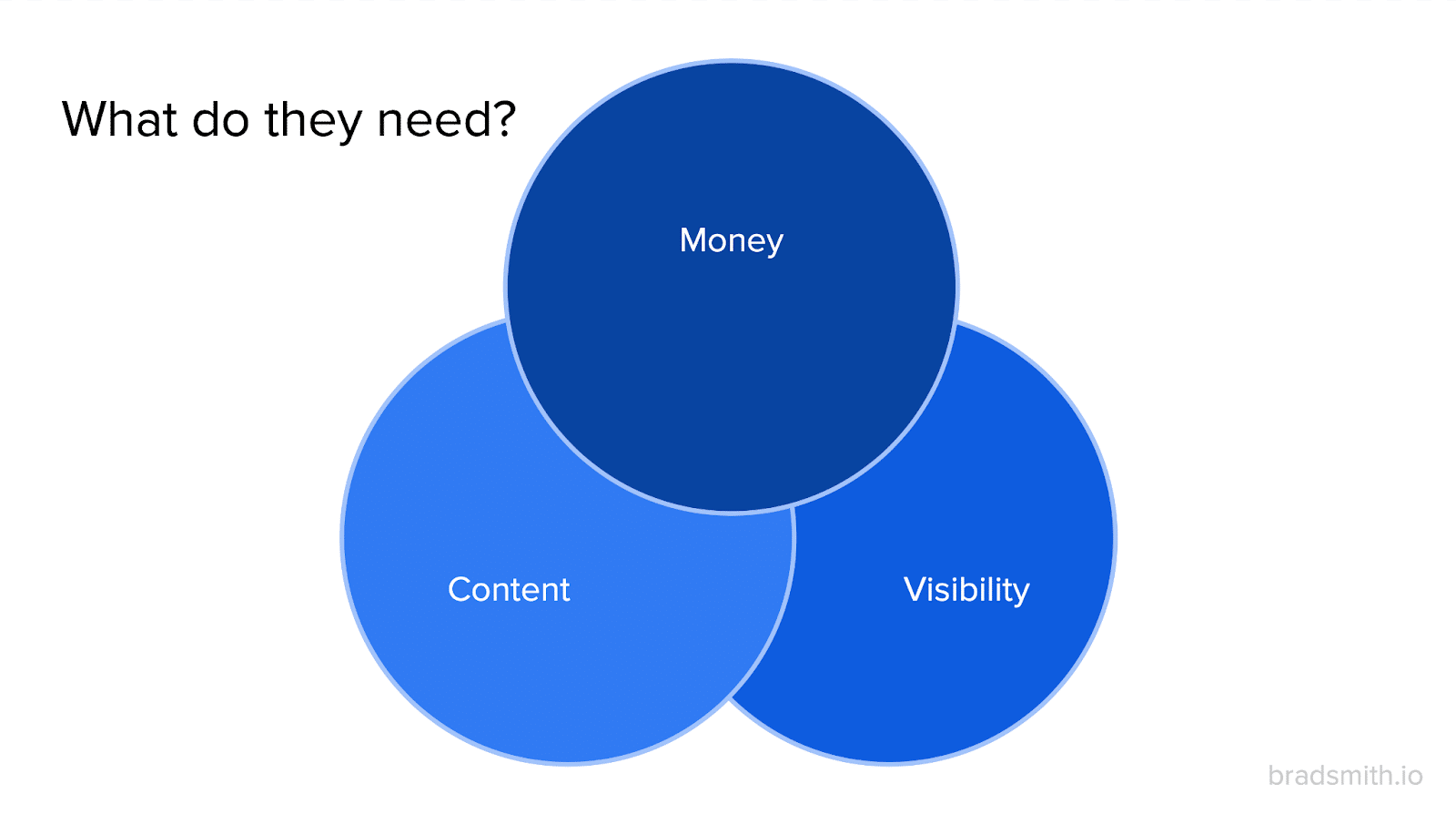
Uncovering what they need first and then supplying that paves the way to reciprocation.
Fourth degree: Extremely scalable but less relevant
Now we’re moving into the gray area.
On the one hand, fourth-degree links are often extremely scalable. But on the other, they’re usually a lot less relevant, too.
Fourth-degree links are less relevant for audience or theme, or as an alternative to your product or service. Think: links for links sake with no other value.
You can spot these by the following warning signs:
- Sites tend to be lower DR ranges (think: <40)
- Paid-for links (“sponsored” and similar)
- Artificial / abused tactics (scholarships, widget/embeds, and more)
- Other “gray” tactics (second-tier link building, expired domains, etc.)
These are your old-school, SEO 1.0-style tactics. You already know the kind.
Basically, anything that looks like this:
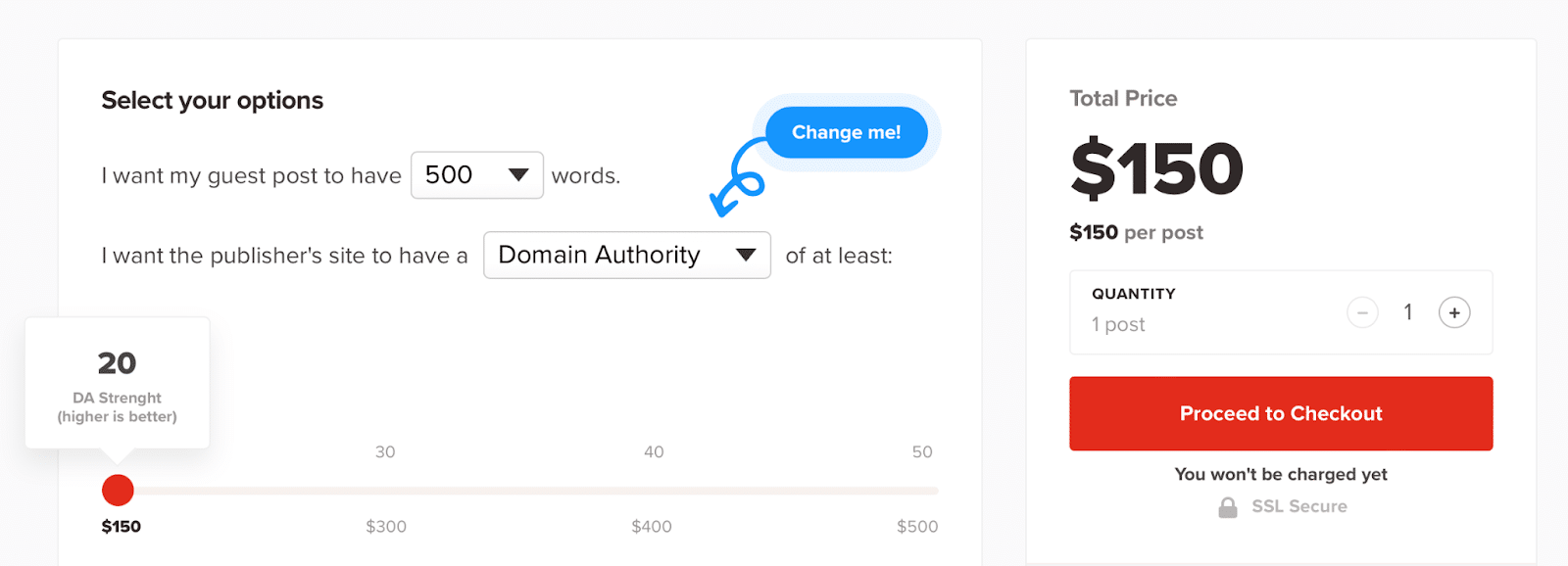
As a general rule, the more scalable a link building tactic, the less desirable (low quality and less relevant) it is.
So.
Should you still use these?
Possibly, yes!
You need both quantity and quality in the long run to succeed.
This real-world acceptance separates the link building pros (who see what actually works) from all the empty, hollow, fauxfluencers out there who never descend their privileged-ivory-tower positions.
So should these 80% of your links?
No! Unless you want to be penalized one day or don’t care about the site long term.
But.
Should these be <10-20% of your links? Sure, why not.
If you reverse-engineered your biggest competitors today, I guarantee you’ll often find a worse ratio.
So keep reality in perspective.
Fifth degree: Not relevant and low quality (yet still extremely scalable)
Last but not least, fifth-degree links (and beyond) are typically very low quality and highly risky (i.e., they are ignored completely or risk penalization through manual action):
These include:
- Outright spam sites
- Vices (Viagra, gambling, etc.)
- DR <20, no traffic sites
- PBNs
These are the ones you avoid like the plague!
Not only because they’re truly “not relevant,” but more importantly because they aren’t likely going to drive you buyers, either.
We don’t really need to beat this dead horse anymore, do we?
The degrees of link relevance
Link relevance is fluid. It’s a sliding scale or spectrum.
So while it’s true that some links are “not relevant,” more common is that links can be “highly” or “mostly” or “slightly” relevant.
And you commonly need all of those to achieve scale!
‘Cause often, the “most” relevant links are also the hardest to get, build, land, or pay for.
If the biggest competitors in your space have tens of thousands of referring domains at minimum (which most lucrative spaces all do), then you can’t be overly picky.
You’ll still need tons and tons of “mostly” relevant and “slightly” relevant links.
These audience-focused ones might seem “less relevant” at first glance.
But they’re also what helps you eventually balance both quantity and quality in the long run.
The post The 5 degrees of link relevance appeared first on Search Engine Land.


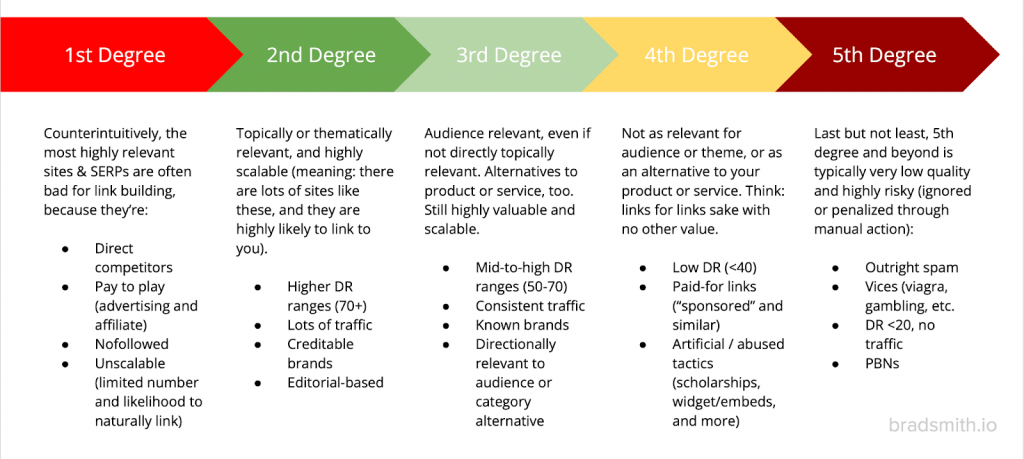




Recent Comments